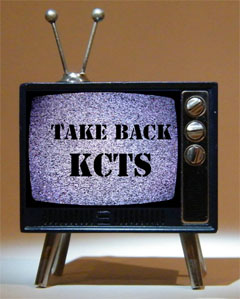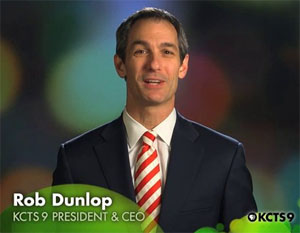LOCAL
Sign petition to help ‘Take Back KCTS,’ save PBS in Seattle
SEATTLE (May 22, 2015) — Community members are concerned that the sweeping production cuts and profit-driven decisions of KCTS Channel 9’s corporate management, which could include the imminent auctioning off of its federally licensed frequency to broadband companies, might spell the end of local Public Broadcasting System television in Seattle.
 Members of Electrical Workers (IBEW) Local 46 and their community supporters have started a Take Back KCTS petition online to the KCTS 9 Board of Directors to take steps to “maintain the standards of excellence set over many decades by KCTS leadership, employees, and members.” It calls for the corporate-dominated Board to include more representation from community stakeholders, including the station’s employees, and to include younger voices and people of color.
Members of Electrical Workers (IBEW) Local 46 and their community supporters have started a Take Back KCTS petition online to the KCTS 9 Board of Directors to take steps to “maintain the standards of excellence set over many decades by KCTS leadership, employees, and members.” It calls for the corporate-dominated Board to include more representation from community stakeholders, including the station’s employees, and to include younger voices and people of color.
TAKE A STAND — Sign it NOW!
BACKGROUND, provided by Angela Marshall of IBEW Local 46:
In September 2013, the Chair of the KCTS Board of Directors, Paula Rosput Reynolds — a former Safeco CEO, chief restructuring officer of AIG, and an executive and board member of many major oil and gas companies — announced that the board would replace Moss Bresnahan, a seasoned PBS executive, with Rob Dunlop, a former KOMO Radio and Fisher Broadcasting Corp. executive. Almost immediately, Dunlop began making a series of far-reaching changes in the station.
Loss of Community and Worker Appreciation
Prior to 2013, KCTS’ stated the mission was to “improve the quality of life in the communities we serve by providing meaningful programming on air, online and in the community that informs, involves and inspires.” Since that time the mission has changed and, along with it, much of the direction of the station. The mission is now “To Inspire A Smarter World.”
Ironically, the change included enormous reductions in the areas of the station which might have seemed to most live up to the new mission. For example, KCTS’ education unit was closed down, its outreach unit drastically cut back and eventually shuttered, its popular Science Café (run in cooperation with the Pacific Science Center) and History Café (a partnership with the Museum of History and Industry), were ended, and its national distribution unit, which prepared KCTS program for wider broadcast to other PBS stations, was also shut down. Also in 2013, the station announced drastic cuts in employee health care benefits and the elimination and restructuring of many jobs.
These policies led to a serious reduction of the KCTS workforce and community pledge drives. While pledge drives are not popular with everyone, they do allow an opportunity for the community to thank the station for its service and for the workers and volunteers of KCTS to thank subscribers and members for their generous gifts that make it possible for the station to provide excellent PBS and community-driven programming.
The most recent, and perhaps most questionable of these decisions was the elimination of a dozen producing, photography, editing, and audio positions, with the result that only a couple of members of the station’s production unit remain.
While the station has seen other layoffs during earlier management regimes, they have been made necessary, at least in part, by serious financial straits — in one case the station was millions of dollars in debt. But as even Dunlop admitted, there was no financial need to lay off these workers.
 In an interview, Dunlop stressed that the cutbacks were not financially driven. The station’s latest audited financial report shows that it had a surplus of $460,940 in fiscal 2014, compared with a $47,843 loss in FY13. Underwriting was also up $178,000 and total revenue grew by $293,000 during that period.
In an interview, Dunlop stressed that the cutbacks were not financially driven. The station’s latest audited financial report shows that it had a surplus of $460,940 in fiscal 2014, compared with a $47,843 loss in FY13. Underwriting was also up $178,000 and total revenue grew by $293,000 during that period.
There was no crisis of viewership either; he told KUOW radio that the station audience is currently “stable.”
Recently the station has announced a Digital First Initiative that will eliminate studio productions, studio pledge drives, and, according to Dunlop, will dramatically change the way local programming is produced and made available to viewers. If these changes prevail, the KCTS community will receive much of its local programming solely in short-form videos delivered mostly through phones, computers and tablets rather than broadcasting. The rationale for this is that younger viewers are not watching the television broadcasts.
Dunlop claims that KCTS’ audience is mainly children and viewers over the age of 50. While this is true, it is not new. KCTS has always been more attractive to older viewers, who are also more likely to contribute. So the elimination of so much that KCTS does must be driven by other motives beyond the PBS mission. One of the most troubling is the possibility that KCTS management may plan to sell off their digital channels to other media conglomerates.
The Spectrum Auction
In 2016, The FCC will hold an auction that will allow broadcasters to sell all or part of their federally- licensed frequency to the highest bidder. Why? Because the lower frequency of TV travels farther and penetrates walls better. This makes the TV band more valuable to broadband companies.
“A Consumer Electronics Association (CEA) study claimed that $62 billion worth of spectrum could become $1 trillion for wireless, and one proposal would require all TV stations, including LPTV, to give up all spectrum, with subsidized multichannel services replacing over-the-air TV, even after viewers spent a great deal of money on the DTV transition.”
This means that the frequency allocated to broadcast television is 16 times more valuable to broadband providers than it is to TV station owners, according to the study. That is a powerful reality that is not widely understood.
So, we have no choice but to ponder how the shift from TV to other media will be made, and what, if anything, will replace local public television as a community service. The valuable model of community-funded television allows KCTS to meet a public need. If the station is shifting focus away from viewer funded television and shifting toward a larger funding source or sale of its license, the average viewer’s voice could be drowned out.
Will our KCTS Vme and Create channels be sold to the highest bidder?
Some anonymous unconfirmed reports tell us that KCTS may be undergoing plans to get out of the community license contracts for its Vme and Create channels that especially serve the Hispanic community and children. Is this a way to seize upon the lucrative sale of the TV frequency public asset? If the TV frequency is going to go to something else, what will take the place of Local TV?
Traditional broadcasters oppose the idea of shutting down some or part of television to be replaced by broadband. According to Broadcast and Cable Magazine:
“Wireless companies are asking the government to participate in the biggest consumer bait-and-switch in American history. For the last few years, the government told consumers that digital television would bring them free over-the-air HDTV and more channels. Now, after purchasing billions of dollars in new digital equipment and antennas, wireless advocates are asking the government to renege on its promise. High-definition programming and more digital channels would become the sole and exclusive province of pay services. The American public simply will not stand for this.” (November 2, 2009).
The airwaves, and particularly Public Television belong to the public, not to venture capitalists, and we indeed must not stand for their widespread sale.
The FCC’s concept of selling this public asset to the highest bidder is a travesty.
Why should any temporary license holder of a broadcast license make a killing off of selling public property? And, of course, when a windfall profit is to be made, speculators arrive on the scene to capitalize:
Beginning in 2010, a large number of station acquisitions began to occur among a group of companies referred to as “spectrum speculators”. Backed by private equity groups, these companies have primarily purchased smaller, low-rated stations within or in close proximity to major markets, with an intent to possibly sell the stations and their licenses during the incentive auction, and no interest in their future operation as a television station.
KCTS Board of Directors – Lack of community representation
Since changes began in 2013 at KCTS, the number of people employed by the station will have shrunk from more than 100 to less than 80 employees when the recent layoffs go into effect. Meanwhile, positions on the Board of Directors have increased from 14 Directors to 18 Directors.
Today, 15 out of the 18 Directors come from backgrounds in corporate management, banking, business, consulting, legal, and for-profit media. Only three of the Directors come from community and non-profit backgrounds and only one member of the board is a person of color. While having board members with connections to money is helpful, they must not be allowed to dominate the board of a public and community institution like KCTS.
Despite the fact that one-third of KCTS employees are represented by a union and that the Board of Directors is responsible for overseeing financial affairs, human resources, compensation strategy, and reviewing employee benefit plans, there is not one voice from a labor background on the governing KCTS Board of Directors.
KCTS operates under a community license, it should reflect the community in its staff, leadership, and its donors.
KCTS dramatically reduced its original programming between FY13 and FY14. and at the same time, KCTS viewership both online and on TV dropped between FY13 and FY14. The amount of active donors went down in FY14 while the average individual donation rose in value. This means that KCTS has less community membership. These numbers give pause to the idea that less original local television programming will sustain membership, viewership, and individual donations.
Elimination of award winning journalists, producers and technicians; elimination of volunteer and community-driven funding events like studio pledge drives; and reduction of benefits and working conditions that attract dedicated professionals to tell us the stories we need to hear means a loss to our community.
TAKE A STAND — Sign the petition to Take Back KCTS!
Email Angela Marshall for more information.





